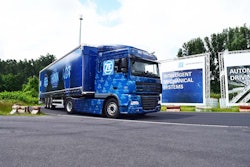 The dash of a Model S
The dash of a Model SThe DOT announced last week it’s investigating a fatal Florida crash in which a Tesla Model S — driving in the vehicle’s self-driving Autopilot mode — failed to brake and slammed into the side of a Class 8 tractor-trailer, killing the occupant of the Tesla. Tesla vehicles are all-electric sedans that can operate in semi-autonomous modes in certain situations.
The truck involved in the May 7 crash pulled in front of the Tesla to take a left across a divided highway. The Tesla’s Autopilot system failed to brake to avoid the collision and drove underneath the truck’s trailer. The trailer’s “white side…against a brightly lit sky” caused the car’s Autopilot system to fail to register the full-sized tractor-trailer crossing the highway, Tesla said in a blog post on its site.
The National Highway Traffic Safety Administration’s Office of Defects has announced an inquiry into the fatal crash, which took place in early May.
Tesla says its Autopilot system is still in public beta testing, and users are warned before using the system that the technology is new and that drivers should not take their hands off the wheel. “When drivers active Autopilot, the acknowledgment box explains, among other things, that Autopilot ‘is an assist feature that requires you to keep your hands on the steering wheel at all times,’ and that ‘you need to maintain control and responsibility for your vehicle’ while using it,” Tesla writes in its blog.
Reports indicate the driver of the vehicle was watching a movie on his iPad at the time of the crash.
Tesla says this is the first fatal accident in more than 130 million miles of Autopilot testing — well above the U.S. average of 1 death per 90 million miles and the worldwide average of one death per 60 million miles.










